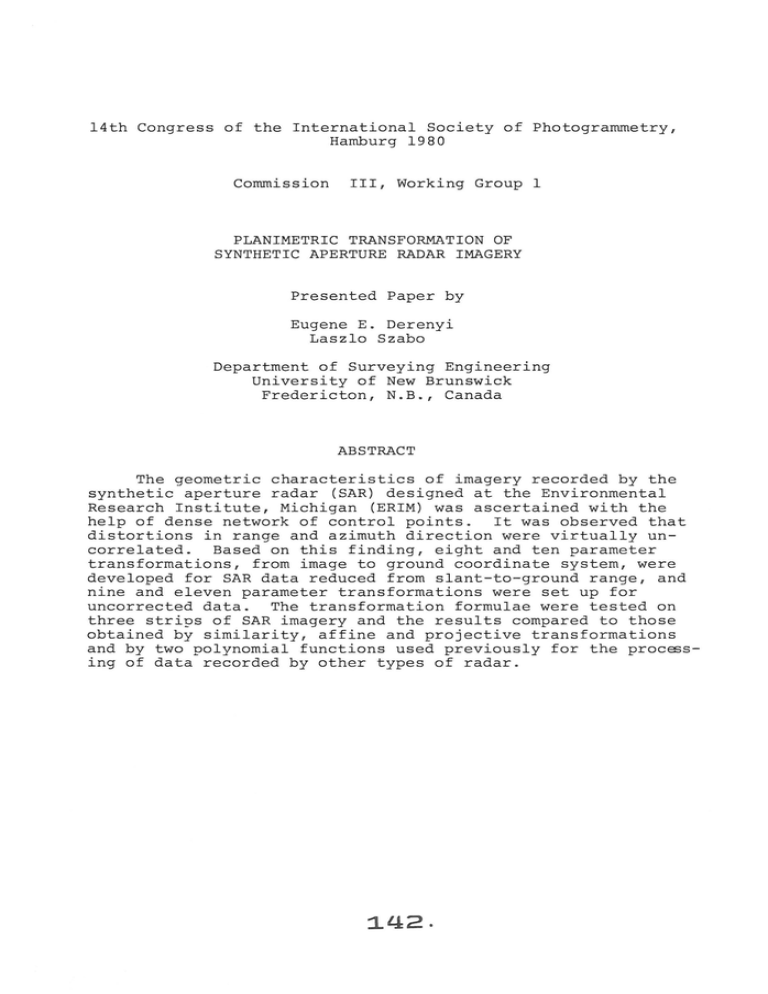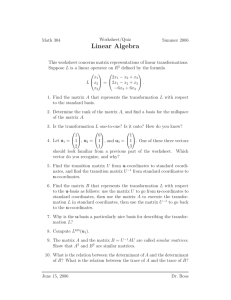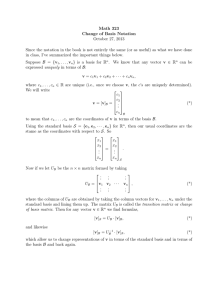14th Congress of the International ... Hamburg 1980 Commission III
advertisement

14th Congress of the International Society of Photograrnrnetry,
Hamburg 1980
Commission
III , Working Group 1
PLANIMETRIC TRANSFORMATION OF
SYNTHETIC APERTURE RADAR IMAGERY
Presented Paper by
Eugene E . Derenyi
Laszlo Szabo
Department of Surveying Engineering
University of New Brunswick
Fredericton , N. B ., Canada
ABSTRACT
The geometric characteristics of imagery recorded by the
synthetic aperture radar (SAR) designed at the Environmental
Research Institute , Michigan (ERIM) was ascertained with the
help of dense network of control points .
It was observed that
distortions in range and azimuth direction were virtually un correlated . Based on this finding , eight and ten parameter
transformations , from image to ground coordinate system , were
developed for SAR data reduced from slant - to - ground range , and
nine and eleven parameter transformations were set up for
uncorrected data . The transformation formulae were tested on
three strips of SAR imagery and the results compared to those
obtained by similarity , affine and projective transformations
and by two pol y nomial functions used previously for the procffis ing of data recorded by other types of radar .
INTRODUCTION
Continuing improvements in the spatial resolution of
imaging radar systems coupled with a unique all-weather capability enhance the cartographic potential of radar imagery.
Possible applications, in this connection, include the locating
of targets in surveillance activities, displaying interpreted
information in a spatial context and facilitating mapping and/
or revision of maps in remote areas and in regions where
unfavourable weather conditions persist. Although, it is
possible to determine elevation from side-lapping strips, at
the present time radar images are primarily regarded as a
source of planimetric data.
Mapping in photograrnrnetric terms means the transformation
of image coordinates to a ground coordinate system. To perform
this task, one must formulate a mathematical model which not
only performs the transformation, but also compensates for
the numerous inherent systematic errors of the image. Leberl
[1972] and others have studied in depth the geometric characteristics of side-looking radar and suggested various parametric
and non-parametric methods for the transformation. For practical applications, however, it is most important to find an
optimized solution to the problem at hand; that is to arrive
at a method which provides an acceptable solution in the
simplest possible way . Hence , an investigation is being conducted at the University of New Brunswick to develop such a
method for the planimetric transformation of airborne synthetic
aperture radar (SAR) imagery . The results obtained thus far
are discussed in this paper.
METHOD OF APPROACH
Acquiring radar imagery by a synthetic aperture system
requires a rather complex integrated array of onboard navigational and control instruments . Testing the performance of
each individual component and then propagating the errors to
ascertain the geometric characteristics of the image is a
rather complex operation .
In addition, there are a handful of
SAR system configurations in operation at present and none
of them are identical . Therefore, it is more feasible to examine the final product, determine experimentally its geometric
characteristics and then devise a suitable mathematical model
for the transformation . Hence, this is the method of approach
adopted for this project .
The imagery investigated was acquired with a dual frequency , dual - polarization SAR , designed at the Environmental
Research Institute of Michigan (ERIM) and installed in a
Convair - 580 aircraft of the Canada Centre of Remote Sensing.
Hence , the configuration was referred to as SAR- 580 . The two
frequencies of operations were the X and the L-band . The
sensor was operating in a shallow angle mode, with a depression
angle of 24 . 4° at the centre of the beam . At a flying
altitude of 6 km above ground , this mode provided a ground
range offset of 1 0 km and a swath width of 6 km . The imagery
was recorded as a slant- range display at an approximate scale
of 1 : 135000 . Three strips of X- band recording in HH po l ari zation were tested thus far . Each strip was about 55 km long .
Image coordinates were measured in a Wild STKl comparator .
The coordinate system was defined so that the x - axis was
pointing in the azimuth (f l ight) direction . Ground control
va l ues were estab l ished by ana l ytical aerotriangulat i on and
block adjustmen t of 1: 50000 scal e phot ography and from 1: 20000
scale orthophoto maps .
First the measured image coordinates were pre - processed ,
i . e . corrected for the effect of earth curvature and reduced
to ground range us i ng the average terrain elevation . No
ground control points were employed at this stage . Next the
pre - processed image coordinates were transformed to the ground
coordinate system by an aff i ne transformation using al l avail able ground coordinates as contro l. The residua l s at the
control points were then p l otted as a function of t h e location
of the points on the image .
Through a detai l ed examination of these plots Szabo [1980]
has found that the errors in range and azimuth direction are
virtua ll y uncorrelated .
In pa r t i cu l ar , it was obse r ved that
- there is no apparent functional relationship between the x component of the residuals and the y coordinates ;
- there is no apparent functional re l ationship between t ye y components of the residuals and the y coordinates ;
- the x - component of the residuals is a function of the x
coordinates ;
- the y - component of the residua l s is also a function of the x
coordinates ; and
- the ~ hange of the x - component as a funct i on of the x coordi nate tends to occur a t a faster rate than that of the y component .
Based on these - rather subjective - conc l usions , correc tions can be app l ied to the image coordinates , whereby
x' = x +
~x(x)
and
y' = y +
~y(x)
where x ', y ' are the corrected image coord i nates ; x , yare the
measured and pre - processed image coordinates ; ~x(x) , ~y(x) are
the corrections as a function of the x coordinates , which can
be approximated by an a l gebraic polynomial , such as
~x(x)
~y(x)
a x
n
=
n
b xm
m
(l)
The corrected image coordinates were then introduced into the
affine transformation equation, so that
X= A1 + A2
+
[x+~x(x)]
A
3
[y+~y(x)]
( 2)
If the image and the ground coordinate systems are nearly parallel, the coefficients A3 and B2 are small and their products
with the correction terms can be neglected. A substitution of
(1) into (2) yields
A
xn
X = Al + A2 x + A3y
(n+2) rft3)
B(m+2)x
Transformation formulae of various degrees can now be set
up, depending on the degree of the polynomial selected for
~x(x) and ~y(x).
Two such versions were tested [Szabo, 1980].
In the one, the first four terms of (3) were included for both
X and Y.
This eight parameter transformation was named G8. In
the other, terms one to six were used for X, while Y remained
as before. This version was called GlO.
First, each strip was transformed in its full length in
one operation (long strip mode); then about one half of each
strip was transformed as a unit {short strip mode).
In each
case,l4 regularly distributed points were used as control to
compute the transformation parameters and the rest of the
points were employed as check points.
For the sake of comparison, each long and short strip was
also processed by similarity affine and projective trans formation and by the following two polynomial functions:
(The
same control points were used in each transformation) .
y
2
2
3
+ A6 x y + A x
7
2
2
3
+ B x y + B7 x y
= Bl + B x + B3y + B xy + B x
2
4
5
6
X = Al + A x + A3y + A xy + A x
5
4
2
( 4)
and
2
+ A6 x y
2
2
+ B6y
= Bl + B x + B3y + B xy + B x
4
2
5
X = Al + A x + A3y + A4 xy + A x
2
5
y
2
( 5)
The above polynomials were successfully used for the processing
of imagery recorded by other radar system configurations and
were not specifically selected for the imagery at hand. Formula (4) was suggested by Derenyi (1974], while (5) was used by
Laberl [1972] .
Occasionally, all information needed for earth curvature
correction and slant-to - ground range reduction may not be
available.
In this case a correction term can be added to the
y image coordinates, which is a function of y, such as
( 6)
:l.l:I:S.
For a nearly parallel image and grou~d coordinate system
this will result in the addition of a B5 y term to the Y polynomial . Hence , the number of coefficients were increased by
one in each version of the transformation . The new formulae
were identified as S9 and Sll [Szabo, 1980] .
PRESENTATION AND DISCUSSION OF RESULTS
Tables l and 2 present the root mean square (RMS) errors
of position for the check points after the various types of
transformation . The results in Table l were obtained with
pre - processed image coordinates , while Table 2 shows the out come of the transformations when uncorrected measurements were
used .
In each case 14 control points were employed .
The RMS
values tabulated here , are weighted averages pertaining to the
three strips . There were a total of 118 check points avail able for the three long strips and a total of 82 check points
for the short strips . All values are shown in metres .
TABLE 1 :
Strip
RMS OF DISCREPANCIES IN POSITION AT CHECK
POINTS (in metres)i DATA REDUCED
TO GROUND RANGE .
T r a n s f 0 r m a t i o n s
Proj
Eq . 4
Eq . 5
G8
Sim
Aff
Long
27 . 8
25 . 8
22 . 2
19 . 7
22 . 2
19 . 4
19 . 4
Short
16 . 0
12 . 0
ll. 7
ll. 3
ll. 6
ll. 5
9.9
Notations :
Sim = similarity i Aff = affine i
Proj = projective i Eq . 4 and Eq . 5 =
equations (4) and (5) respectively in
the text .
TABLE 2 :
Strip
GlO
RMS OF DISCREPANCIES IN POSITION AT CHECK
POINTS (in metres) i DATA IN SLANT RANGE
T r a n s f 0 r m a t i o n s
Proj
Eq . 4
S9
Eq . 5
Sim
Aff
Long
58 . 6
35 . 1
32 . 7
29 . 0
22 . 6
21 . 8
21.8
Short
43 . 7
19 . 8
19 . 2
19 . 4
12 . 1
11 . 9
10 . 3
Sll
Systematic errors of considerable magnitude were present
i n the uncorrected radar imagery . This fact is clear l y i llus trated in Table 2 by the large errors r emaining after simi lar i ty tran sformation . Affine transformation reduced the errors
considerab l y and further , significant improvements were
achieved by po l ynomial transformation . However , the best
resu l ts were attained when the measurements were also pre processed (see Table l) .
Projective transformat i ons had only
a marginal advantage over the affine transformation . This
is understandable, since radar imagery is not a central perspective .
A comparison between the results obtained with thevarious
polynomials indicate that the solution is rather sensitive to
the form of higher order terms . Hence , an increase in the
number of terms does not necessarily improve the accuracy of
the transformation .
Significant improvement was gained in the results when
the length of the strip processed as a unit was reduced .
The cartographic potential of SAR imagery can best be
examined by relating the results to map accuracy standards .
Widely accepted standards in North America require , that on
Class A maps 90% of well defined features shall be located
within 0 . 5 rnrn of their true position . Position accuracies at
the 90% confidence level attained with pre - processed measure ments and GlO transformation are 0 . 23 rnrn and 0 . 12 rnrn for the
long and short strips respectively . Hence , it is possible to
extract planimetric information with digital mapping techniq~
from this particular SAR imagery which will satisfy Class A
mapping standards at scales of 1 : 100000 to 1 : 50000 .
CONCLUSIONS AND RECOMMENDATIONS
Within the limits of the available information the following conclusions were drav.n :
- The eight parameter transformation GB is regarded as the
optimum method for the planimetric transformation of SAR
imagery which was recorded in ground range presentation or
was corrected accordingly . An extension of the polynomial
to 3rd and 4th order terms in X- direction leads to apprec iable improvements of the results only in short strips with
rather dense control . The optimum method of transformation
for slant range recording is polynomial S9 for long strips
with sparce control and Sl l for short strips with dense
control .
- For ground range recording of a short strip with dense control , affine transformation can yield res u lts which c l osely
watch those obtained wi th polynomial GB .
In other cases ,
however , especially when slant range remains uncorrected ,
polynomials provide far superior resu l ts .
- It is highly recommended to correct for slant range distor tion before transformation . Data reduced from slant to
ground range , generally yields better results with GB trans format i on than the uncorrected data wi th Sll transformation .
- SAR- 580 imagery has definite potentia l as a source of info rmat i on for the revision of 1 : 50000 scale Class A maps , when
digital mapp i ng techniques are employed .
ACKNOWLEDGEMENT
This investigation was performed as part of the Canadian
Surveillance Satelli te Project . It was supported by an Energy,
Mines and Resources , Canada and a University of New Brunswick
grant in aid of Research . Aerotriangulation to provide ground
control was performed at the Surveys and Mapping Branch ,
E . M. R.
REFERENCES
Derenyi, E ., 1 974: SLAR Geometric Test . Photogrammetric
Engineering, Vol . 40, No . 5, pp . 587 - 604 .
Laberl, F., 1 972 : Evaluation of Single Strips of Side -Looking
Radar Imagery.
Invited paper for Commission IV, 12th
Congress of International Society of Photogrammetry ,
Ottawa .
Szabo , L., 1980: Planimetric Transfor~ation of Airborne SAR
Imagery, M.Sc .E. Thesis, Department of Surveying
Engineering , University of New Brunswick , Fredericton .




